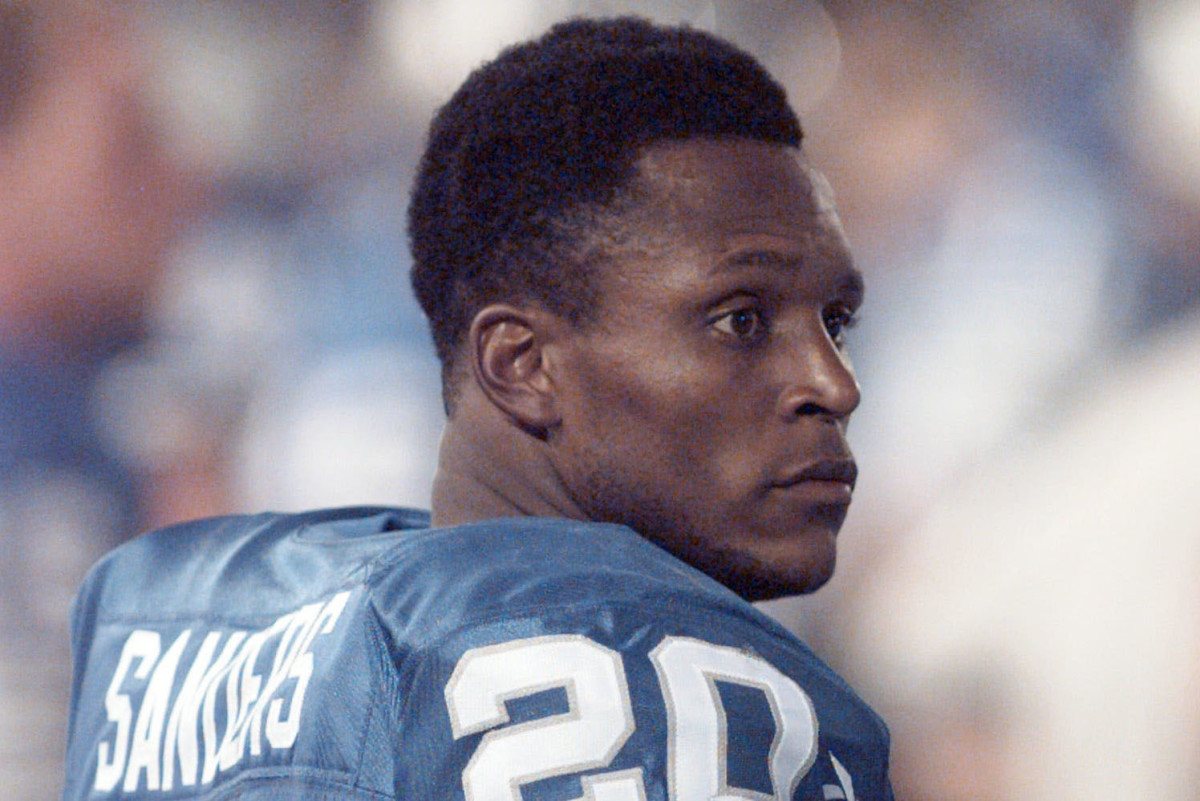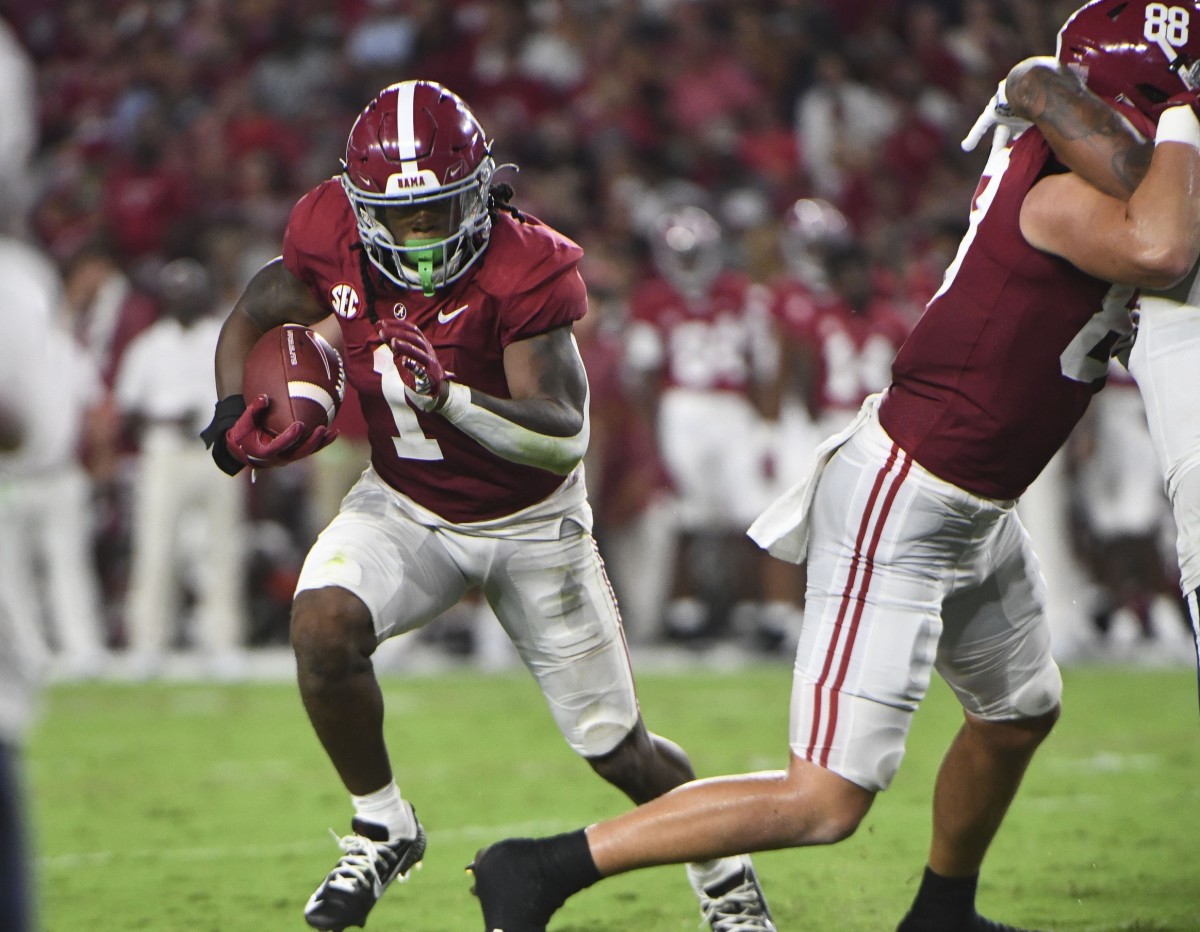Jahmyr Gibbs Could Be Next Victim of the Curse of Barry Sanders
There’s the Curse of the Bambino. The Curse of the Billy Goat. The SI cover jinx. The Curse of the Madden cover. Professional sports have endured more than their share of curses over the years. Well, I’ve stumbled upon another one that could affect your 2023 fantasy drafts.
I've called it the "Curse of Barry Sanders."
In 1989, the Lions drafted Sanders with the third overall pick in the NFL draft. He went on to become one of the greatest running backs not only in the history of the NFL, but also in the world of fantasy football. He rushed for over 1,000 yards in all 10 of his seasons in the league, including 2,053 yards in 1997. Sanders also rushed for double-digit scores six times and finished his career with 15,269 rushing yards and 109 touchdowns.

Despite rushing for 1,491 yards in 1998, Sanders – who was 30 at the time – decided to retire after that season. In the 23 years since Sanders left the franchise, the team has drafted 23 running backs including 10 who have been selected in the first three rounds. The latest, of course, is Jahmyr Gibbs out of Alabama, who the Lions selected with the No. 12 overall pick in the 2023 draft.
When the Lions decided to trade D’Andre Swift, who was a first-round pick in 2020, Gibbs’s stock increased. With Swift out of the picture, Gibbs will only need to share carries with David Montgomery. A prominent pass catcher, Gibbs will now be a high pick in fantasy drafts.
Lions running backs in NFL drafts
Before we dig deeper into Gibbs’s value, let’s focus on the Lions’ most prominent selections at the position since Sanders retired. In the 2000 NFL draft, Detroit took Reuben Droughns in the third round. He finished his career in the Motor City with 72 rushing yards. Droughns rushed for 1,200-plus yards twice in his career, but both came with the Broncos.
In 2004, the Lions selected Kevin Jones with the 30th overall selection. He had a decent rookie season, posting 1,133 rushing yards and finishing as the RB21. His best season from a fantasy standpoint came in 2006, when he had 61 catches with eight total touchdowns and finished 15th in points among running backs. Unfortunately for Jones, his other two seasons with the Lions were forgettable due to injuries and a lack of statistical production.
The next two running backs the Lions selected in the first three rounds of the draft, Brian Calhoun (2006) and Kevin Smith (2008), also failed to meet expectations. Calhoun had just 14 carries over two seasons (11 games) with the team. Smith was much better, at least in his first two seasons, ranking as the RB17 as a rookie and the RB21 in 2009. He would play in just 25 games over his final three seasons in Detroit, however.
In 2010, the Lions took Jahvid Best with the No. 30 pick. He was a mid-tier No. 2 runner as a rookie, finishing 19th on the strength of his 58 receptions. That was the extent of his success, though, as he played in just six games the rest of his career due to concussions.
The next three runners the Lions drafted in one of the top three rounds were Mikel Leshoure (2011), Ameer Abdullah (2015), and Kerryon Johnson (2018). Leshoure missed his entire rookie campaign with a torn Achilles tendon. After serving a two-game suspension the following season, he totaled over 1,000 scrimmage yards and nine touchdowns. Those numbers were good enough for him to finish 19th in fantasy points among running backs. However, Leshoure would be released in 2014 after playing just three more games.
Abdullah was considered a prominent sleeper in fantasy football circles after being selected in Round 2 of the 2015 draft. But like the Lions backs before him, Abdullah was unable to meet expectations. In fact, he failed to rank better than 49th in fantasy points among backs during his time in the Motor City. The hits would keep on coming at the position, too.
The next high running back pick the Lions made was Johnson, who was labeled a sleeper or breakout candidate in fantasy land. He certainly showed some potential as a rookie with 641 rushing yards and a 5.4 yards-per-attempt average in 10 games. Injuries limited Johnson to eight games the following season though, and he was out of the league in 2021.
The final high draft pick the Lions used on a runner (before Gibbs) was Swift.
He was a viable No. 1 back as a rookie, finishing 18th in PPR points while sharing some of the carries with Adrian Peterson. He was slightly better in his second season, posting over 1,000 yards from scrimmage while finishing 15th in points among backs. The wheels fell off last season, though, as Swift missed time due to injuries and lost vital touches to Jamaal Williams. In all, Swift ranked 21st and was a disappointment from a fantasy standpoint.

The Lions ultimately decided to dump Swift, trading him to the Eagles two days after drafting Gibbs. In all, he ended up being yet another dud in the long list of duds the team has drafted at the position. All told, the best finish any of these backs has had in PPR leagues is RB15. But while there have been a few decent seasons here and there, for the most part, these running backs have failed to be consistent fantasy producers.
The case against Gibbs
This all might mean absolutely nothing as it pertains to Gibbs, of course, And for those who don’t buy into trends, all this information doesn’t mean a hill of beans. The skeptics will say, “Well, Gibbs has different coaches and a different team around him than all of those guys.”
And that would be true, but it still doesn’t dismiss this “trend.” Heck, the Jets have had a lot of different people in charge of scouting, drafting, etc., and they haven’t been able to pick a good quarterback in the draft since Joe Namath! It’s an interesting trend, at the very least.
The fact remains though, that if you followed this trend and avoided any of Detroit’s backs since Sanders in either redraft or especially dynasty leagues, well, you’d look pretty smart.
Will Gibbs be the next to be cursed? We’ll find out.
